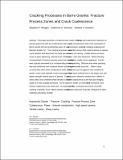| dc.contributor.author | Morgan, Stephen P. | |
| dc.contributor.author | Johnson, Catherine A. | |
| dc.contributor.author | Einstein, Herbert H. | |
| dc.date.accessioned | 2016-06-17T17:36:42Z | |
| dc.date.available | 2016-06-17T17:36:42Z | |
| dc.date.issued | 2013-02 | |
| dc.identifier.issn | 0376-9429 | |
| dc.identifier.issn | 1573-2673 | |
| dc.identifier.uri | http://hdl.handle.net/1721.1/103144 | |
| dc.description.abstract | This paper presents a comprehensive study of the cracking and coalescence behavior of granite specimens with pre-existing flaw pairs. Uniaxial compressions tests were conducted on Barre granite with pre-existing flaw pairs of varying inclination angles (β), bridging angles (α) and ligament lengths (L). The cracking processes were recorded using a high speed camera to capture crack initiation and determine the mode (tensile or shear) of cracking. Visible fracture process zones of grain lightening, referred to as “white patching”, were also observed. White patching corresponded to fracture process zones that developed before visible cracks appeared. Cracks were typically preceded by a corresponding linear white patching. Diffusive area white patching was also observed near locations where surface spalling eventually occurred. Shear cracks occurred less often when compared to other brittle materials such as gypsum and marble and tensile cracks were typically much more jagged in shape (saw-toothed) due to the larger size and higher strength mineral grains of granite. Crack coalescence behavior trended from indirect to direct shear and combined shear-tensile to direct tensile coalescence as the flaw pair bridging angle (α) or flaw angle (β) increased. As the ligament length (L) between flaws increased, more indirect coalescence was observed. As expected, due to the increased occurrence of tensile cracking in granite, more indirect tensile coalescence was observed in granite compared to other materials previously studied. | en_US |
| dc.description.sponsorship | MIT Energy Initiative | en_US |
| dc.description.sponsorship | National Science Foundation (U.S.) (NSF (Award No. 0555053)) | en_US |
| dc.description.sponsorship | United States. Dept. of Energy (DOE (DEFG- 06GO16061)) | en_US |
| dc.description.sponsorship | United States. Army Research Office (ARO (Award No. 007492-001)) | en_US |
| dc.publisher | Springer Netherlands | en_US |
| dc.relation.isversionof | http://dx.doi.org/10.1007/s10704-013-9810-y | en_US |
| dc.rights | Creative Commons Attribution-Noncommercial-Share Alike | en_US |
| dc.rights.uri | http://creativecommons.org/licenses/by-nc-sa/4.0/ | en_US |
| dc.source | Springer Netherlands | en_US |
| dc.title | Cracking processes in Barre granite: fracture process zones and crack coalescence | en_US |
| dc.type | Article | en_US |
| dc.identifier.citation | Morgan, Stephen P., Catherine A. Johnson, and Herbert H. Einstein. “Cracking Processes in Barre Granite: Fracture Process Zones and Crack Coalescence.” International Journal of Fracture 180, no. 2 (February 22, 2013): 177–204. | en_US |
| dc.contributor.department | Massachusetts Institute of Technology. Department of Civil and Environmental Engineering | en_US |
| dc.contributor.mitauthor | Morgan, Stephen P. | en_US |
| dc.contributor.mitauthor | Einstein, Herbert H. | en_US |
| dc.relation.journal | International Journal of Fracture | en_US |
| dc.eprint.version | Author's final manuscript | en_US |
| dc.type.uri | http://purl.org/eprint/type/JournalArticle | en_US |
| eprint.status | http://purl.org/eprint/status/PeerReviewed | en_US |
| dc.date.updated | 2016-05-23T12:07:10Z | |
| dc.language.rfc3066 | en | |
| dc.rights.holder | Springer Science+Business Media Dordrecht | |
| dspace.orderedauthors | Morgan, Stephen P.; Johnson, Catherine A.; Einstein, Herbert H. | en_US |
| dspace.embargo.terms | N | en |
| dc.identifier.orcid | https://orcid.org/0000-0002-7478-3277 | |
| dc.identifier.orcid | https://orcid.org/0000-0003-4074-4736 | |
| mit.license | OPEN_ACCESS_POLICY | en_US |
| mit.metadata.status | Complete | |
